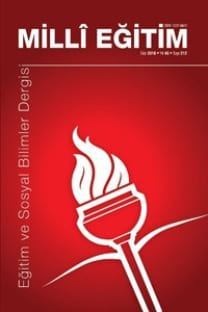PANDEMİ SÜRECİNDE K-12 DÜZEYİNDE UZAKTAN EĞİTİM: DURUM ÇALIŞMASI
Uzaktan Eğitim Sürecinin Tasarımı, Öğretmen Görüşleri, Case Study
K-12 DISTANCE EDUCATION IN THE PANDEMIC PROCESS: A CASE STUDY
___
- Anderson, T. (2008). The theory and practice of online learning. Canada: Athabasca University Press.
- Beetham, H., ve Sharpe, R. (2007). Rethinking pedagogy for a digital age: Designing and delivering e-learning. NewYork: Routledge. Erişim Adresi: https://joshuakoop.weebly.com/uploads/5/6/3/6/56367463/rethinking_pedagogy_for_a_digital_age.pdf
- Boettcher, J. V. 1999. The dangers and pitfalls of communicating with students or what not to do when communicating with students on the Internet. Erişim Adresi: http://www.cren.net/~jboettch/comm.htm
- Barbour, M. K., and T. C. Reeves. 2009. The reality of virtual schools: A reviewof the literature. Computers and Education52 (2): 402–416.
- Basilaia, G., & Kvavadze, D. (2020). Transition to Online Education in Schools during a SARS-CoV-2 Coronavirus (COVID-19) Pandemic in Georgia. Pedagogical Research, 5(4), em0060. https://doi.org/10.29333/pr/7937
- Cavanaugh, C. S., Gillan, K. J., Kromrey, J., Hess, M., & Blomeyer, R. (2004). The effects of distance education on K–12 student outcomes: A meta-analysis. Naperville, IL: Learning Point Associates.
- Cavanaugh, C., M. K. Barbour, and T. Clark. 2009. Research and practice in K–12 online learning: A review of literature.International Review of Researchin Open and Distance Learning10 (1). Erişim Adresi: http://www.irrodl.org/index.php/irrodl/article/view/607
- Creswell, J. W. (2013). Qualitative inquiry & research design: Choosing among fiveapproaches. Los Angeles, USA: Sage.
- Çelik, H., Başer Baykal, N. ve Kılıç Memur, H. N. (2020). Nitel veri analizi ve temel ilkeleri. Eğitimde Nitel Araştırmalar Dergisi – Journal of Qualitative Research in Education, 8(1), 379-406. doi:10.14689/issn.2148-2624.1.8c.1s.16m
- Clark, T. (2001). Virtual schools: Trends and issues -A study of virtual schools in the United States. San Francisco, CA: Western Regional Educational Laboratories.
- Clark, T. (2003). Virtual and distance education in American schools. In M. G. Moore (Ed.), Handbook of distance education (pp. 673-699-168). Mahwah, NJ: Lawrence Erlbaum Associates, Inc. Research and Practice in K-12 Online Learning: A Review of Open Access Literature. Erişim Adresi: https://www.researchgate.net/publication/26588061_Research_and_Practice_in_K-12_Online_Learning_A_Review_of_Open_Access_Literature
- Daniel, S.J. (2020). Education and the COVID-19 pandemic. Prospects . https://doi.org/10.1007/s11125-020-09464-3.
- Demir, E. (2015). Açık ve uzaktan öğrenmenin katılım ve devamlılık stratejilerinde akademik takvim. Açıköğretim Uygulamaları ve Araştırmaları Dergisi, 1(4), 36-58.
- Edelson, P. J., & Pittman, V. V. (2001). E-Learning in the United States: New directions and opportunities for university continuing education. Global E-Journal of Open, Flexible & Distance Education, 1(1), 71–83.
- Henderson, M. ve Romeo, G. (2015). Teaching and digital technologies big issues and critical questions. Australia: Cambridge University Press. Erişim Adresi: http://assets.cambridge.org/97811074/51971/frontmatter/9781107451971_front matter.pdf
- İşman, Aytekin (2011). Uzaktan Eğitim, Ankara: Pegem Akademi.
- Karademir, T. (2018). Teknolojinin Benimsenmesine Ekolojik Bir Yaklaşım: Sürdürülebilir Bir Dijital Öğretim Materyali Geliştirme Ekosistemi. Yayınlanmamış Doktora Tezi, Ankara Üniversitesi, Eğitim Bilimleri Enstitüsü.
- Karen Woo, Maree Gosper, Margot McNeill, Greg Preston, David Green & Rob Phillips (2008) Web-based lecture technologies: blurring the boundaries between face-to-face and distance learning, ALT-J, 16:2, 81-93, DOI: 10.1080/09687760802315895
- Moore, M. G. (2007). The theory of transactional distance. In M. G. Moore (Ed.), Handbook of distance education, 2nd ed., 89–104. Mahwah, NJ: Erlbaum.
- Ozan Leylum, Ş., Odabaşı, H. F., & Kabakçı Yurdakul, I. (2017). Eğitim ortamlarında durum çalışmasının önemi. Eğitimde Nitel Araştırmalar Dergisi - Journal of Qualitative Research in Education, 5(3), 369-385. www.enadonline.com DOI: 10.14689/issn.2148- 2624.1.5c3s16m
- Özer, M. (2020). Educational policy actions by the ministry of national education in the times of COVID-19. Kastamonu Education Journal, 28(3), 1124-1129. doi: 10.24106/kefdergi.722280
- Phipps, R., & Merisotis, J. (1999). What’s the difference? A review of contemporary research on the effectiveness of distance learning in higher education. Washington, DC: Institute for Higher Education Policy. Erişim Adresi: http://www2.nea.org/he/abouthe/diseddif.pdf.
- Reimers, F. M. (2020). What the Covid-19 Pandemic will change in education depends on the thoughtfulness of education responses today. Worlds of Education, Erişim Adresi: https://www.worldsofeducation.org/en/woe_homepage/woe_detail/16727/%E2%80%9Cwhat-the-covid-19-pandemic-will-change-in-education-depends-on-the-thoughtfulness-of-education-responses-today%E2%80%9D-by-fernando-m-reimers
- Rice, K. (2006). “A Comprehensive Look at Distance Education in the K–12 Context.” Journal of Research on Technology in Education 38, 425 - 448.
- Rogers, E. (2003). Diffusion of innovation. New York: Free Press.
- Sintema, E. J. (2020). Effect of COVID-19 on the Performance of Grade 12 Students: Implications for STEM Education. Eurasia Journal of Mathematics, Science and Technology Education, 16(7), em1851. https://doi.org/10.29333/ejmste/7893
- Stake, R.E. (1995). The art of case study research. Thousand Oaks: Sage Pbc.
- Telli, S. G., & Altun, D. (2020). Coronavirüs ve çevrimiçi (online) eğitimin önlenemeyen yükselişi. Üniversite Araştırmaları Dergisi, 3(1), 25-34
- Yin, R.K. (2014). Case study methods: design and methods (5. Baskı). Thousand Oaks: Sage Pbc.
- ISSN: 1302-5600
- Yayın Aralığı: Yılda 4 Sayı
- Başlangıç: 1973
- Yayıncı: Milli Eğitim Bakanlığı
ÖĞRETMEN ADAYLARININ COVID-19 PANDEMİSİ SÜRECİNDE UZAKTAN EĞİTİM UYGULAMALARINA İLİŞKİN GÖRÜŞLERİ
Serkan DÜZGÜN, Süleyman Erkam SULAK
Mehmet YAVUZ, Bünyami KAYALI, Şener BALAT, Selçuk KARAMAN
PANDEMİ SÜRECİNDE K-12 DÜZEYİNDE UZAKTAN EĞİTİM: DURUM ÇALIŞMASI
KORONAVİRÜS SALGINININ EĞİTİM FAKÜLTESİ ÖĞRENCİLERİNİN KELİME HAZİNELERİNE YANSIMASI
